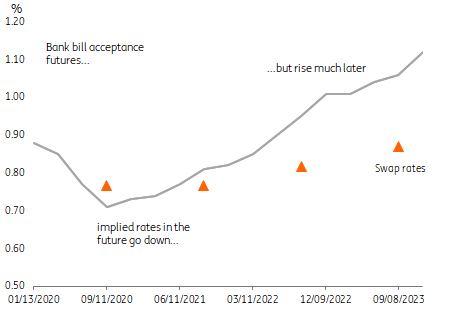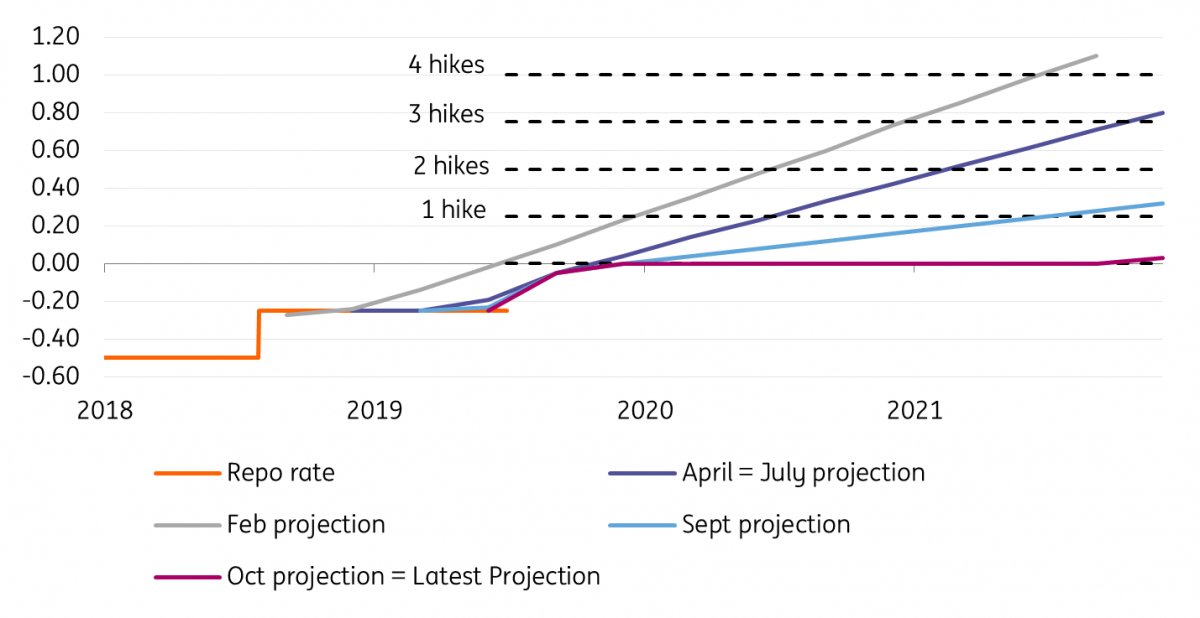What to expect from G10 central banks in 2020
Discover what ING's economists are expecting from global central banks over the next twelve months
Timeline: ING's global central bank outlook
European Central Bank: A new owl on the block
At her first press conference as ECB president, Christine Lagarde characterised herself as neither a monetary policy hawk nor a dove but a wise owl. This wisdom will clearly be put to test in 2020. With the economy hovering between stagnation and a soft rebound, core inflation marginally creeping up and the adverse effects of the ECB’s unconventional measures getting more attention calls for a recalibration of monetary policy could get louder towards the end of the year.
The strategy review could also lead to slight changes in the ECB’s definition of price stability towards “around 2%”, instead of “below but close to 2%”. Such a change would introduce symmetry, while at the same time ensuring sufficient discretionary power to adjust monetary policy even if inflation forecasts and expectations are not yet close to 2%.
All of the above combined with the ECB’s calls on governments to step up investments means that the ECB would prefer staying on hold throughout the entire year. In the absence of any economic accidents, we expect the discussion on a recalibration of monetary policy to gain traction towards the end of the year.
Core Eurozone inflation creeping up

Federal Reserve: The ebb and flow of geopolitics
The US economic picture has improved in recent months thanks to a combination of an easing in US-China trade tensions and monetary stimulus in the form of three Federal Reserve rate cuts. The phase one trade deal between the US and China is scheduled to be signed on 15 January and this will hopefully draw a line under the tit-for-tat escalation in tariffs experienced over the past two years that have hurt business sentiment and activity. Nonetheless, there is little sign of this positive news feeding through into improvements in the US manufacturing sector just yet.
Investment spending remains soft and is not expected to improve significantly in 2020 given the ongoing profits squeeze and political uncertainty due to the upcoming Presidential election. Recent developments in the Middle East could add to a sense of unease.
Nonetheless, the jobs market remains firm while the housing market looks to be a decent source of growth in 2020. Mortgage rates are much lower than 12 months ago and this has led to a pick-up in demand with homebuilder confidence at record highs.
If trade and geopolitical risks subside then the likelihood is we will see the Federal Reserve on hold through 2020. However, our confidence that politics will provide a benign backdrop is low given the upcoming impeachment trial and the prospect of a brutal presidential election battle. US-EU trade tensions could also be a threat for 2020. As such we see the risks skewed towards modest additional policy easing from the Fed in mid-2020.
US housing is a relative bright-spot
Bank of England: Still too early to pencil in cuts
Analysts are heavily divided on the outlook for the Bank of England this year. Talk of a rate cut is building, particularly after some mildly dovish-sounding comments from Governor Mark Carney last week.
Two members of the committee voted to cut rates back in December, and recent comments from MPC voter Silvana Tenreyro suggest that number could rise. All of this comes amid signs that the jobs market is deteriorating. Vacancy levels and job-to-job flows have fallen, while through the autumn the PMIs were pointing to non-replacement of staff.
But it’s still early days, and the limited evidence available suggests sentiment has improved since December’s election. The latest Markit/REC employment also points to the first rise in permanent staff appointments in a year.
Of course, the Brexit saga is far from over, and there are plenty of question marks surrounding the UK government’s ambition to agree to a free-trade deal this year.
That suggests a rate cut can’t be completely ruled out. But for the time being, we think the Bank will hold off on easing, barring a more significant deterioration in the state of the jobs market.
Early evidence sentiment has improved

Bank of Japan: 'All out of ammo'
The Bank of Japan meets on 21 January, and there will be no expectation of any change in policy from a central bank that is widely, and accurately regarded as being out of all effective ammunition.
Perhaps finally realising that negative bond yields were not only damaging to bank net interest margins but also weighed on returns to household savings, the BoJ has allowed longer-term bond yields to drift up to around zero in recent months. The overnight call rate, which has an official target rate of -0.1%, has instead averaged closer to -0.04% in recent months.
It would be hard to put these developments down as deliberate policy actions by the BoJ, but in “allowing” them to occur while at the same time, making no change to undershoots of their claimed bond-buying targets, it looks as if the excesses of recent qualitative and quantitative easing (QQE) are being relaxed.
In the background, the government’s fiscal policy is designed to smooth the potential for a 2019/2020 slump as the consumption tax hike clashes with the end of Tokyo Olympics construction spending. A further slump will now need avoiding in 2021, and then after that, in 2022 and so on. All this costs in terms of persistent deficits and debt ratios.
Japanese policy rates

Bank of Canada: Domestic Troubles
After the December policy meeting, the Bank of Canada argued that downside risks from trade conflicts need to be set against “the sources of resilience in the Canadian economy – notably consumer spending and housing activity.” The fact that the phase one deal between the US and China is soon to be signed therefore appears supportive of ongoing stability in monetary policy.
Certainly wage growth is robust and unemployment is fairly low, but we sense there are cracks forming. Recent data has shown that GDP rose just an annualised 1.3% in 3Q 2019 and actually fell in October. Retail sales figures have been subdued despite strong pay gains and even housing activity has shown evidence of slowing; building permits have fallen in six of the past ten months.
Given this backdrop we expect payrolls growth to continue its softening trend and with unemployment closer to 6% rather than the 3%-4% handle comparable economies have, we believe that wage growth will slow further. This doesn’t alter the outlook for stable policy at the 22 January Bank of Canada policy meeting, but it leaves the possibility of action open for subsequent meetings.
Canadian jobs figures

People's Bank of China: Further easing to have limited impact on yuan
We expect the PBoC to continue to use both interest rate and liquidity policy tools in 2020.
There has been no complete rollback of US tariffs, and the emergence of a technology war suggests we should expect one to two further cuts of 5bp in the 7-day repo and 1-year MLF. Cuts in the MLF should translate into cuts in the 1-year LPR and 5-year LPR by the same extent. This should result in an almost parallel downward shift of the China sovereign yield curve, although liquidity tools will change the shape of the curve.
A liquidity injection will place extra downward pressure on the short end of the yield curve, slightly steepening the curve.
The PBoC is expected to inject liquidity via open market operations, including the MLF, to smooth out ad-hoc liquidity tightness. The central bank has already announced to cut the broad-based reserve requirement ratio (RRR) by 0.5 percentage points in January to meet massive loan demand at the start of the year.
All of this loosening in monetary policy should have limited impact on the yuan however, which has been more reactive to the news on the trade war and the technology war.
If these challenges linger on, then the PBoC is likely to maintain looser monetary policy in 2021.
China's new interest rates

Reserve Bank of Australia: One more cut to support the economy in flames
The RBA’s first meeting of the year is on 4th February, and it promises to deliver one of only a few rate cuts out of the APAC region this year.
We were leaning towards the RBA being on hold this year after their 75bp easing last year. But a combination of events has caused us to allow for one more cut. The devastating bushfires that have affected almost the entire country, but especially the more populous SE states and the Australian Capital Territories, have done more than just cause considerable environmental damage and loss of life. While some pundits have been quick to compare this event to natural disasters such as earthquakes, which also causes lots of balance-sheet damage but can have little direct impact on GDP near-term, this does not accurately describe the GDP impact of these bushfires.
Instead, these fires can more adequately be described by the economic activity suppressing the impact of an event like an epidemic – SARS for example. Although the collateral balance sheet damage from this was insignificant, the indirect impact on business and household behaviour was substantial, and prolonged, delivering a big hit to GDP.
With inflation still moribund, though picking up later this year, and in the absence of any support from the government, which seems dogmatically wedded to tight fiscal policies, the RBA will likely throw out a shaky lifeline in the form of a further 25bp of easing, taking the overnight cash rate to 0.5%. This is more of a token cut than anything and will do little to help the fire-ravaged economy back on to its feet. Time and mother nature will be more useful, though some fiscal help would also have been very beneficial.
Implied policy rates

Reserve Bank of New Zealand: Slowly shifting away from Australia as inflation picks up
Although New Zealand has been blanketed by drifting smoke from the Australian fires, it has few of the same problems. The economy seems in better shape, despite historical growth in recent times being revised down. That said, the trend growth rate remains fairly steady, and we should see inflation figures picking up shortly, as negative base effects dissipate, taking them closer to the RBNZ’s inflation target midpoint of 2% (an easier target to hit than the RBA’s 2.5% mid-point).
A further cut by the RBA does not require the RBNZ to follow suit. Historically, official policy rates in New Zealand have tended to hover 25bp above those in Australia, and given the disparity in economic situations in the two economies, a 50bp spread seems reasonable.
Indeed, with New Zealand house prices picking up sharply in 2019, there may be even more of an argument for not easing further if growth does weaken, though we anticipate that leaning against rapid property price inflation will mainly be the task of macro-prudential measures, than of monetary policy.
RBA and RBNZ cash rates (%)

Riksbank: Don't expect a follow-up to December's rate hike
The Riksbank took a historic decision to exit negative interest rates back in December. Policymakers have become warier about negative rates becoming a more permanent state of affairs, and the effect that might have on people’s expectations.
But against a challenging backdrop for the domestic economy, this 25 basis-point move is unlikely to be repeated imminently. The PMIs have moved further into contractionary territory, while the jobs market looks weaker. We’ve also seen a modest decline in inflation expectations, a sign that doesn’t bode well for forthcoming wage negotiations due to conclude in the spring.
The Riksbank is keen to point out that it could cut rates again, but the move to exit negative interest rates in December signals the bar to doing so is set reasonably high. It would take a fairly pronounced economic downturn for the repo rate to head below zero again. It’s worth remembering too that policymakers are much more relaxed about the risk of currency appreciation than a few years back, following an ongoing period of SEK weakness.
The bottom line is that interest rates are unlikely to move again in either direction any time soon.
Riksbank rate projection over time

Norges Bank: Don't rule out another rate hike
After an active 2019, Norway's central bank looks set for a much calmer 2020. Having hiked interest rates three times last year, the Norges Bank is currently signalling a prolonged pause.
While oil prices have risen and the krone weakened more than the central bank had anticipated during 2020, some of the more recent activity data points to more lacklustre growth in the near-term. The central bank’s own regional network points to a moderation in output, particularly in the retail sector.
But that doesn't mean further tightening can be ruled out - and in fact the Norges Bank's most recent interest rate projection doesn't rule out a rate hike in the first half of 2020. Much will depend on global activity. If world growth regains some poise (which we should note, our US and Eurozone economists are not currently expecting), then that may see the Norges Bank seriously consider some modest tightening. A lot will depend on how the NOK reacts to any positive re-evaluation of growth prospects.
For now we are pencilling in one further rate hike in the second quarter, although this could easily get pushed back.
Norwegian activity showing signs of moderation

Swiss National Bank: Some intervention on the FX market expected
At its latest monetary policy meeting, the SNB left its key interest rate unchanged at -0.75% and remains ready to intervene in the foreign exchange market if necessary. As with every monetary policy assessment for more than two years, it still considers that the franc is highly valued and that the situation on the foreign exchange market remains fragile.
Moreover, the SNB has revised its inflation forecasts downwards, at 0.4% in 2019, 0.1% in 2020 and 0.5% in 2021. These downward revisions can be seen as a rather dovish signal from the SNB because the extremely low level of these forecasts implies that monetary policy can only remain extremely accommodative in the coming years.
With inflation forecasted at 0.1% in 2020, far from the SNB's target and capable of falling below 0% in the event of a negative shock, the SNB can only maintain its interest rates in negative territory and fight against the appreciation of the franc on the foreign exchange market. As things stand now, it seems that no rate increase can be anticipated over the forecast period. We expect the rate to remain unchanged at its current level of -0.75% in the coming years.
Nevertheless, risks are on the downside, which means that if the Swiss economy is hit by a negative shock or if the franc appreciates too much, the SNB could be forced to lower its key interest rate even lower, possibly to -1%. This is not our base scenario, but the risk of a fall in interest rates remains very present.
Swiss inflation

Download
Download articleThis publication has been prepared by ING solely for information purposes irrespective of a particular user's means, financial situation or investment objectives. The information does not constitute investment recommendation, and nor is it investment, legal or tax advice or an offer or solicitation to purchase or sell any financial instrument. Read more





